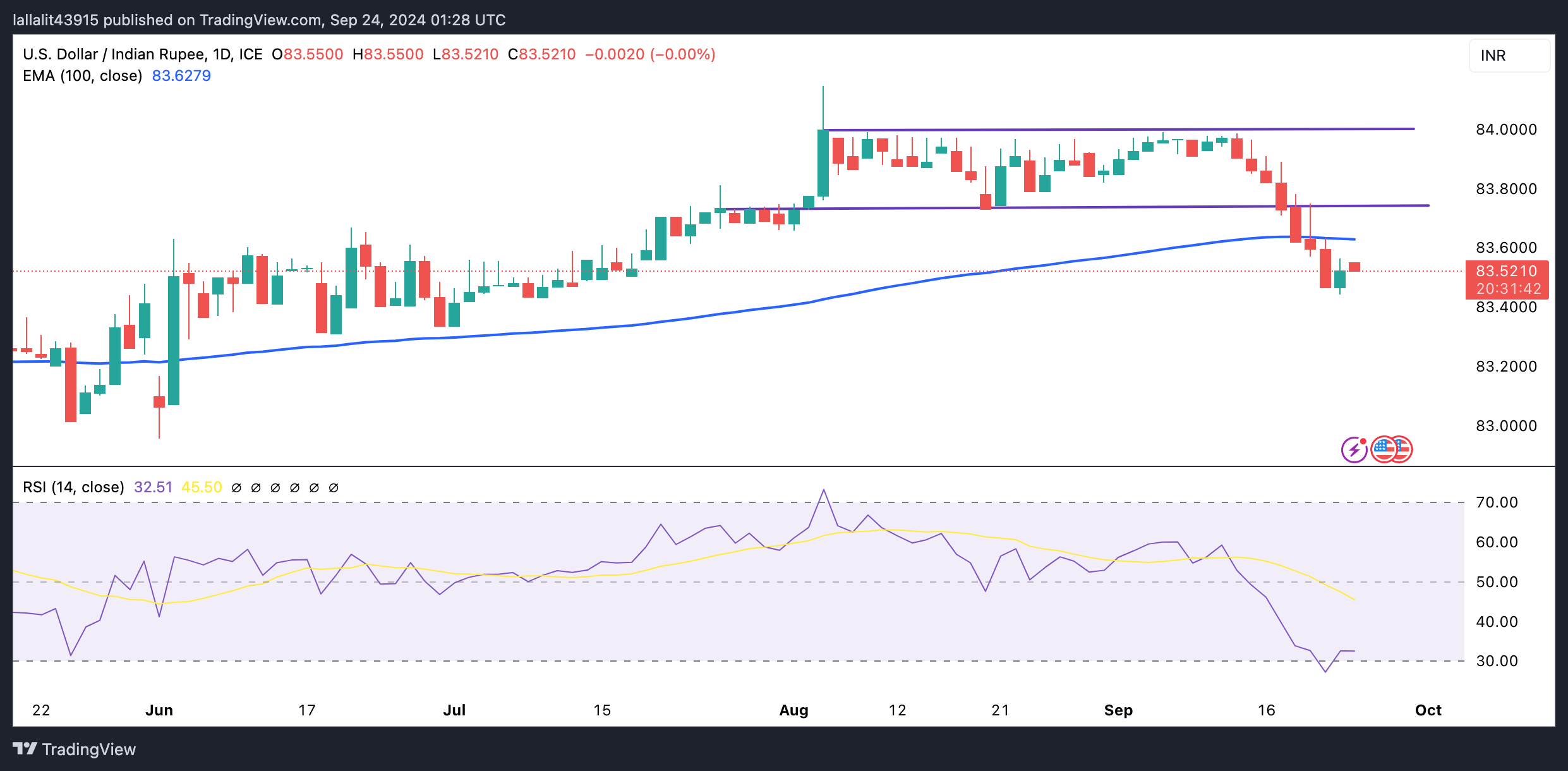- Indian Rupee gathers strength in Wednesday’s early European session.
- Improved risk appetite and a weakening USD support the INR.
- Investors await the US August New Home Sales and Fed’s Kugler speech on Wednesday.
The Indian Rupee (INR) edges higher on Wednesday. Improved risk appetite following China’s stimulus measures and the softer US Dollar (USD) boost the local currency on the day. Nonetheless, rising crude oil prices, outflows related to a rejig of the FTSE equity indexes and renewed USD demand from large Indian importers might exert some selling pressure on the INR.
The US New Home Sales data for August is due on Wednesday. Traders will take more cues from the US Federal Reserve’s (Fed) Governor Adriana Kugler speech. Any dovish remarks from the Fed officials are likely to weigh on the Greenback against the Indian Rupee. The highlight for this week will be the US August Personal Consumption Expenditures (PCE) Price Index data, which will be published on Friday.
Daily Digest Market Movers: Indian Rupee remains firmer amid a global risk-on mood
- S&P Global Ratings on Tuesday retained India's Gross Domestic Product (GDP) growth forecast at 6.8% while noting that the Reserve Bank of India (RBI) may cut interest rates in October.
- "We expect the rupee to trade with a positive bias amid improved global risk appetite following China's stimulus and softness in the dollar. However, elevated crude oil and other commodity prices may cap sharp upside," noted Anuj Choudhary, Research Analyst at Sharekhan by BNP Paribas.
- The Conference Board’s US Consumer Confidence Index dropped to 98.7 in September from a revised 105.6 in August. This figure registered the biggest decline since August 2021.
- Fed Governor Michelle Bowman said on Tuesday that key measures of inflation remain "uncomfortably above" the 2% target, warranting caution as the Fed proceeds with cutting interest rates. However, she preferred the Fed to lower by a quarter percentage point, more in line with the traditional moves at the central bank.
- The markets have priced in nearly 56% odds of a second 50 bps rate cut in the November meeting, while the chance of 25 bps stands at 44%, according to the CME FedWatch Tool.
Technical Analysis: USD/INR’s negative view remains unchanged in the longer term
The Indian Rupee trades on a stronger note on the day. The negative outlook of the USD/INR pair prevails as the price remains capped under the key 100-day Exponential Moving Average (EMA) on the daily chart. The downward momentum is supported by the 14-day Relative Strength Index (RSI), which stands below the midline near 36.00.
The first downside target for the pair emerges at 83.44, the low of September 23. A breach of this level will see a drop to the crucial support level at 83.00, representing the psychological level and the low of May 24.
Sustained trading above the 100-day EMA at 83.62 could pave the way to the support-turned-resistance level at 83.75. The key barrier for USD/INR is located at the 84.00 round mark.
Risk sentiment FAQs
In the world of financial jargon the two widely used terms “risk-on” and “risk off'' refer to the level of risk that investors are willing to stomach during the period referenced. In a “risk-on” market, investors are optimistic about the future and more willing to buy risky assets. In a “risk-off” market investors start to ‘play it safe’ because they are worried about the future, and therefore buy less risky assets that are more certain of bringing a return, even if it is relatively modest.
Typically, during periods of “risk-on”, stock markets will rise, most commodities – except Gold – will also gain in value, since they benefit from a positive growth outlook. The currencies of nations that are heavy commodity exporters strengthen because of increased demand, and Cryptocurrencies rise. In a “risk-off” market, Bonds go up – especially major government Bonds – Gold shines, and safe-haven currencies such as the Japanese Yen, Swiss Franc and US Dollar all benefit.
The Australian Dollar (AUD), the Canadian Dollar (CAD), the New Zealand Dollar (NZD) and minor FX like the Ruble (RUB) and the South African Rand (ZAR), all tend to rise in markets that are “risk-on”. This is because the economies of these currencies are heavily reliant on commodity exports for growth, and commodities tend to rise in price during risk-on periods. This is because investors foresee greater demand for raw materials in the future due to heightened economic activity.
The major currencies that tend to rise during periods of “risk-off” are the US Dollar (USD), the Japanese Yen (JPY) and the Swiss Franc (CHF). The US Dollar, because it is the world’s reserve currency, and because in times of crisis investors buy US government debt, which is seen as safe because the largest economy in the world is unlikely to default. The Yen, from increased demand for Japanese government bonds, because a high proportion are held by domestic investors who are unlikely to dump them – even in a crisis. The Swiss Franc, because strict Swiss banking laws offer investors enhanced capital protection.
Tags: Featured,newsletter





























